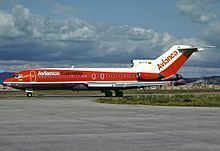Crew 7 Date 17 March 1988 Total fatalities 143 (all) | Passengers 136 Survivors 0 Registration HK-1716 | |
 | ||
Summary Controlled flight into terrain Similar China Southwest Airlines Fl, Ethiopian Airlines Flight 604, Delta Air Lines Flight 1141, CAAC Flight 301, LOT Flight 703 | ||
Avianca Flight 410 was a flight that crashed at 13:17 on March 17, 1988, near Cúcuta, Colombia, that occurred shortly after takeoff when it flew into a mountain. There were 143 deaths and no survivors. It was the aviation accident with the highest death toll in Colombia at the time.
Description
The aircraft was a Boeing 727-21 operated by Avianca, the national airline of Colombia. Flight 410 was a regular scheduled domestic passenger flight from Cúcuta-Camilo Daza International Airport (CUC) to Cartagena de Indias-Rafael Núñez International Airport (CTG). The aircraft crashed at El Espartillo mountain shortly after takeoff from runway 33 at Cúcuta.
The aircraft registration number was HK-1716. That airplane had flown previously with Pan Am, as #N321PA (Clipper Koln-Bonn); it was sold on September 20, 1974, to Avianca. The aircraft was built in 1966, and had 43,848 hours of airframe time.
The crash of Flight 410 held the record for highest death toll of any aviation accident in Colombia until December 20, 1995 when American Airlines Flight 965 crashed into a mountain near Buga, Valle del Cauca, killing 159 people. The cause was determined to be pilot error.
AV410 took off from Cúcuta between 13:13 and 13:17 from runway 33 bound for Cartagena. There was no further information from HK-1716 until ground witnesses claimed that they saw a Boeing 727 flying too low. The plane contacted some trees and then, at 13:18:01, struck the mountain head on. The 727 broke in half and disintegrated when the fuel exploded; the remains were scattered in a 60m radius. There were no survivors among the 7 crew and 136 passengers.
Rescue operations and commissions rushed to the crash site, which was impossible to reach due to nightfall and the resulting low visibility. Area residents provided light and helped the rescuers reach the top of the mountain, where the rest of the ill-fated HK-1716 was. The next day, the remains were transported back to Cúcuta to be identified by their family members.
The official cause of the crash was a controlled flight into terrain at 6,343 feet. The investigation pointed to a number of probable causes, including a non-crew pilot in the cockpit, whose presence diverted the attention of the pilot and who interfered with the operation of the aircraft, and a lack of teamwork (crew resource management) between the pilot and co-pilot.
